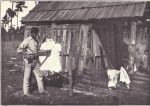The hair having been removed, the skin is placed in a mortar, or in a hole cut a log (see image below) which serves the purpose. Eggs and cornmeal mixed with a little water are then poured over the skin, which is thoroughly beaten with a long wooden pestle.
The skin is then taken from the mortar and wrung rather dry; a number of small holes are cut around the edge and through these cords are passed, which serve to hold the skin stretched between two upright posts, as shown in plate 12, a. While in this position it is scraped and all particles of flesh are removed. The instrument now employed consists of a piece of metal attached to a long wooden handle. A large bone probably served as the primitive implement.
The skin remains stretched until dry, when it is, of course, rather stiff. To soften it, the skin is pulled back and forth over the top of a stake driven into the ground, which has been made smooth and round to prevent tearing the skin.
This process of tanning renders the skin soft and white. The Choctaw claim that it is a very ancient method of preparing skins. Eggs of various kinds, they say, are used with equally good results. The method described, including the use of corn and eggs, may have been followed by all the Southern tribes.
Lawson, 1 in writing of the Indians of Carolina more than two centuries ago, referred to their use of “young indian corn, beaten to a pulp,” in the place of the brains of animals, in preparing skins. “Young indian corn” would probably have about the same effect as the mixture of eggs and cornmeal.
If the skins are to be smoked, a process that renders them more durable. a hole a foot or more in depth is dug in which a fire is kept until a bed of hot ashes accumulates. On this are put pieces of rotten oak, no other wood being used for this purpose; these are not permitted to blaze, as the more smoke that arises the better it is for the skins. These, already tanned soft and white and perfectly dry, are stretched over the hole and allowed to remain in the smoke an hour or more.


(b) Skins to be tanned soft, with the hair remaining. If the skin is dry and stiff it is first softened with clear water, after which it is spread over a beam and scraped on the inner surface to remove all flesh. The inside is then thoroughly rubbed with a mixture of eggs, cornmeal, and water, great care being taken not to wet the outside, or fur. When the skin is about dry, it is pulled and worked back and forth over the top of a stake, as already explained, alter which it remains soft.
Citations:
- Skins to be tanned soft, without the hair. A hole is dug in the ground, its size being determined by the number of skins to be prepared. The walls and bottom are made smooth and water is poured in, which, on account of the nature of the clay and sand formation, remains several hours. The skins are then put into the water, where they are allowed to remain several hours, or sometimes during the night. A hole filled with water, containing several skins, is shown beneath the ax handle in plate 11, a.[
]
